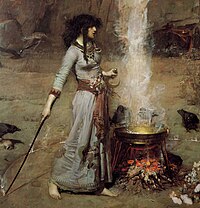
| Part of a series on |
| Witchcraft |
|---|
 |
Neopagan witchcraft, sometimes referred to as The Craft, is an umbrella term for some neo-pagan traditions that include the practice of magic.[1] These traditions began in the mid-20th century, and many were influenced by the witch-cult hypothesis; a now-rejected theory that persecuted witches in Europe had actually been followers of a surviving pagan religion. The largest and most influential of these movements was Wicca. Some other groups and movements describe themselves as "Traditional Witchcraft" to distinguish themselves from Wicca.
In contemporary Western culture, some adherents of these religions, as well as some followers of New Age belief systems, may self-identify as "witches", and use the term "witchcraft" for their self-help, healing, or divination rituals.[2] Others avoid the term due to its negative connotations. Religious studies scholars class the various neopagan witchcraft traditions under the broad category of 'Wicca',[3][4] although many within Traditional Witchcraft do not accept that title.[5]
These Neopagans use definitions of witchcraft which are distinct from those used by many anthropologists and from some historic understandings of witchcraft, such as that of pagan Rome, which had laws against harmful magic.[6]
- ^ Berger 1999, p. 10.
- ^ Clifton 2006, p. [page needed]; Tosenberger 2010; Berger & Ezzy 2009; Kelly 1992.
- ^ Doyle White 2016, pp. 160–162.
- ^ Aitamurto, Kaarina; Simpson, Scott (2016). "36: The Study of Paganism and Wicca". The Oxford Handbook of New Religious Movements, Volume 2. Oxford University Press. p. 482.
- ^ Adler 2006, p. 230.
- ^ Dickie, Matthew (2003). Magic and Magicians in the Greco-Roman World. Routledge. pp. 138–142.
